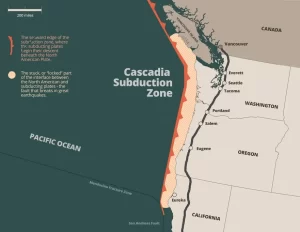 The ground beneath our feet could be more complex than we thought! The Cascadia subduction zone, a giant underwater fault line stretching from California to Vancouver Island, has the potential to unleash massive earthquakes along the Pacific Northwest. New research reveals this megafault isn’t one smooth piece, but rather several sections that could rupture independently.
The ground beneath our feet could be more complex than we thought! The Cascadia subduction zone, a giant underwater fault line stretching from California to Vancouver Island, has the potential to unleash massive earthquakes along the Pacific Northwest. New research reveals this megafault isn’t one smooth piece, but rather several sections that could rupture independently.
This means a future earthquake might impact different areas in very different ways. “For places like Seattle and Tacoma,” says study co-author Harold Tobin, a UW geophysicist, “it could be the difference between a scary jolt and a total disaster.”

Unlike some subduction zones with frequent smaller quakes, Cascadia stays quiet, making it tough to study. But scientists recently gathered new seismic data along a 560-mile stretch of the fault. This data shows the incoming ocean floor isn’t just diving under our continent, it’s also subdivided into four main zones. One zone, stretching from southern Washington to Vancouver Island, is particularly interesting. Here, the plates meet at a shallow angle, creating a large area of contact. Bigger area of contact means bigger potential earthquake, according to the study’s lead author, Suzanne Carbotte.
The last major Cascadia quake hit in 1700, a monster estimated at magnitude 8.7 to 9.2. We don’t know if that quake ruptured the entire fault or just one section. This new understanding of the fault’s structure will help scientists predict future hazards, including ground shaking in places like Seattle and Vancouver, as well as tsunami risks along the coast.
The bottom line? This segmentation means scientists can make better predictions about how strong shaking might be in different areas during a future earthquake. Read more in this Live Science article. Or you might want to watch this PBS YouTube video about ‘The Big One’.
